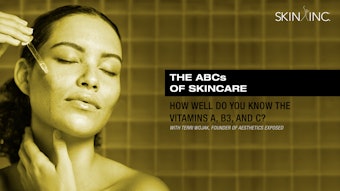“Beauty in the flesh will continue to rule the world.”
—Florenz Ziegfeld
One of the first facts every cosmetic chemist learns is that the skin is the largest organ of the human body. The average human adult has two square meters of skin surface. Then come lessons about lipids and their importance in maintaining healthy skin and controlling transepidermal water loss. Less is known about the wealth of bacterial life on the skin’s surface, and less still about the adult stem cells lurking beneath the surface. New technology and an increased understanding of the biology of skin is opening new avenues for turning back the clock on wrinkles.
The human body is made of a mind-boggling number of cells—about 100 trillion. Within the human body, bacterial cells outnumber (much larger) human cells approximately 10:1. Most of these bacteria are not harmful and, in fact, contribute to normal human growth and development.
The chemical composition of skin varies, dictating what type of bacteria will be present, and because some strains of bacteria can have negative influences, it is important that the balance of microbes be maintained to favor the beneficial bacteria over the potentially harmful ones. The skin’s surface is not always a favorable place for microbial growth because it can be dry and salty. Sweat glands and hair follicles are moist and nutritious environments, and are ideal areas for microorganisms to concentrate.
Further, urea, amino acids, salts, lactic acids and lipids are secreted through the skin and provide a rich growth medium.
At the turn of the 19th century, biologist Elias Metchnikoff wrote Prolongation of Life. The book promoted the connection between longevity and maintaining a proper balance of beneficial microorganisms (bacteria, protozoa, algae and fungi) within the body. It inspired what came to be known as the Probiotic Revolution. Metchnikoff’s theories are now applied to healing, immune system enhancement, disease prevention and life extension. And, in discussing and understanding microbial growth on skin, we must distinguish between probiotics and prebiotics—a term coined by the University of Reading’s Glenn Gibson and the Catholic University of Louvain’s Marcel Roberfroid in 1995.
Whereas probiotics are living microorganisms, prebiotics are nondigestible food ingredients, principally oligosaccharides, that may beneficially affect the host by selectively stimulating the growth and/or activity of a limited number of bacteria. They stimulate the growth of bifidobacteria, a natural part of the bacterial flora in the human body, and are consequently referred to as bifidogenic factors. Bifidobacteria have a symbiotic bacteria-host relationship with humans. They can boost the immune system, and produce lactic and acetic acid that control pH. They also inhibit the growth of other bacteria that have more pathogenic qualities.
Henkel KGaA1 screened materials for prebiotic activity using fluorescence in situ hybridization (FISH), which enables the bacteria to be observed directly on the skin. Ginseng and tea extract demonstrated the desired prebiotic action, and a study showed that subjects who applied these substances saw a decrease in acne after one week and 2.4 times more good than bad bacteria on their skin—demonstrating that these substances corrected imbalances in the skin’s bacterial flora.
To continue reading this article, please click here. You will be redirected to the GCI magazine Web site.
Chemical Reaction: Biology at the Cosmetics Counter
May 21st, 2008










